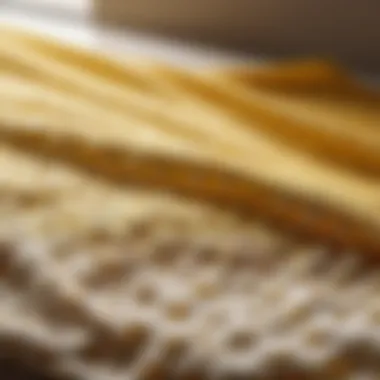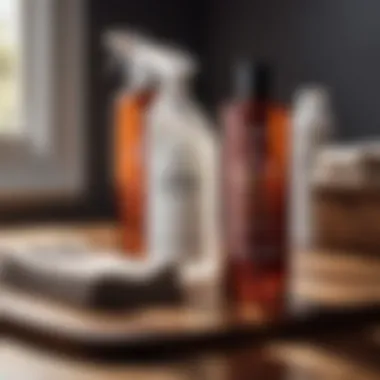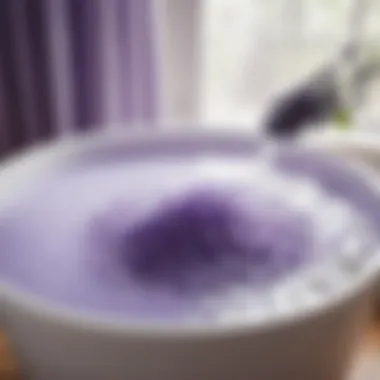Mastering the Art of Pre-Soaking Laundry: Expert Tips for Banishing Tough Stains


Materials:
- Laundry detergent
- Stain remover
- Bucket or container large enough for soaking
- Water
- Soft-bristled brush or sponge
- White vinegar (optional)
- Baking soda (optional)
DIY Steps:
- Preparation: Choose a suitable location for pre-soaking your laundry. Ensure the area is well-ventilated and free from children or pets.
- Sorting: Separate your laundry based on fabric type and color. This helps prevent color bleeding and ensures the best care for each garment.
- Stain Treatment: Inspect each item for stubborn stains. Apply a small amount of stain remover and gently blot the area before proceeding to pre-soak.
- Mixing Solution: Fill the bucket or container with warm water. Add the recommended amount of laundry detergent based on the load size.
- Optional Additives: For tough stains or odor removal, consider adding a cup of white vinegar or a sprinkle of baking soda to the soaking solution.
- Soaking Time: Submerge the garments in the solution. Allow them to soak for at least 30 minutes, or longer for deeply soiled items.
- Agitation: Use a soft-bristled brush or sponge to gently agitate the clothes during soaking, focusing on stained areas.
- Draining and Rinsing: After soaking, drain the water and rinse the clothes thoroughly with clean water to remove detergent residue.
- Final Check: Inspect for any remaining stains. If needed, repeat the pre-soaking process or treat stubborn stains before washing.
- Drying: Once the garments are stain-free, proceed with your regular washing cycle or air dry for delicate items.
Technical Aspects:
- Tools: Soft-bristled brush, sponge
- Timing: Minimum 30 minutes for soaking, additional time for tough stains
- Critical Techniques: Proper stain treatment, correct detergent measurement, gentle agitation
Sequential Steps:
- Prepare the Solution: Create a mixture of warm water and detergent in the designated container.
- Soak the Laundry: Submerge the garments, ensuring each piece is fully covered by the solution.
- Agitate Gently: Use the brush or sponge to work on stains and distribute the detergent evenly.
- Rinse Thoroughly: Drain the water, and rinse the clothes under running water until no soap bubbles remain.
- Inspect and Repeat: Check for any lingering stains or odors, repeating the process if necessary.


Troubleshooting Tips:
- If stains persist after pre-soaking, try spot treating with concentrated stain remover before washing.
- For delicate fabrics, test a small inconspicuous area before full pre-soaking to avoid damage.
- Adjust soaking time based on the severity of stains, opting for longer periods for older or set-in stains.
Introduction
Laundry care is a crucial aspect of maintaining clean and fresh clothes, and pre-soaking serves as a key technique in effectively tackling tough stains. This article delves into the detailed process of pre-soaking laundry, offering insights on the importance of pre-soaking and various techniques to optimize this method. From addressing different types of stains to choosing the right pre-soaking solution, this guide provides a comprehensive overview for housewives and house owners seeking a successful laundry routine.
Understanding the Significance of Pre-Soaking
Why Pre-Soaking is Essential for Laundry Care
Pre-soaking plays a vital role in laundry care by allowing stains to loosen before the wash cycle, enhancing the effectiveness of stain removal. It acts as a proactive measure against stubborn stains, ensuring cleaner clothes. The key characteristic of pre-soaking lies in its ability to penetrate fabric fibers, breaking down tough stains effectively. This method is a popular choice as it provides a practical solution for treating various types of stains efficiently.
Benefits of Pre-Soaking
The benefits of pre-soaking include increased stain removal effectiveness, extended garment lifespan, and reduced reliance on harsh chemicals during the washing process. Pre-soaking allows for gentle yet thorough stain treatment, resulting in fresher and brighter clothes. Its unique feature lies in its versatility, making it suitable for a wide range of fabrics and stain types. However, precaution should be taken with delicate fabrics to avoid damage.


Types of Stains Pre-Soaking Can Address
Pre-soaking proves effective in treating a diverse range of stains, including oil-based, protein-based, and tannin-based stains. It can address common culprits such as grass stains, bloodstains, and coffee spills. The key characteristic of pre-soaking in this context is its ability to break down different stain compositions, ensuring comprehensive removal. While pre-soaking is beneficial for most stains, certain delicate fabrics may require special care to prevent damage.
Choosing the Right Pre-Soaking Method
Traditional Soaking vs. Quick Soaking
The choice between traditional soaking and quick soaking depends on the nature of the stains and fabric types. Traditional soaking involves immersing garments in water for an extended period, allowing stains to dissolve gradually. Quick soaking, on the other hand, uses shorter soaking times for more immediate stain treatment. The key characteristic of traditional soaking lies in its thoroughness, while quick soaking offers a convenient solution for minor stains. Each method has its advantages and disadvantages, requiring consideration based on specific laundry needs.
Considerations for Different Fabric Types
When selecting a pre-soaking method, it's essential to consider the fabric type to avoid potential damage. Delicate fabrics like silk or wool may require gentler soaking solutions to prevent fiber weakening. The key characteristic of considering different fabric types is to ensure compatibility between the soaking solution and fabric composition. While traditional soaking may work well for sturdy fabrics, quick soaking is preferable for delicate materials. Understanding fabric requirements is crucial for successful stain removal and garment care.
Pre-Soaking Solutions and Detergents
Homemade Pre-Soaking Solutions


Homemade pre-soaking solutions offer a cost-effective and eco-friendly option for stain removal. Ingredients like baking soda, vinegar, or hydrogen peroxide create effective soaking mixtures that target stains without harsh chemicals. The key characteristic of homemade solutions is their customization potential, allowing users to tailor the mixture to specific stain types. While homemade solutions are beneficial for the environment and budget-friendly, they may require longer soaking times compared to commercial detergents.
Commercial Pre-Soaking Detergents
Commercial pre-soaking detergents are specially formulated to target specific types of stains, offering convenience and efficiency. These detergents contain enzymes and surfactants that enhance stain removal power, making them ideal for tough stains. The key characteristic of commercial detergents is their optimized stain-fighting formulas, guaranteeing reliable results. While commercial detergents are effective, they may contain chemicals that could impact sensitive skin or the environment.
Eco-Friendly Options
For environmentally conscious individuals, eco-friendly pre-soaking options provide a sustainable alternative to traditional detergents. Plant-based ingredients and biodegradable formulations make eco-friendly options safe for both fabrics and the planet. The key characteristic of eco-friendly choices is their commitment to reducing chemical exposure and promoting eco-conscious laundry practices. Although eco-friendly options are gentle on the environment, they may require longer soaking times for effective stain removal.
Best Practices for Pre-Soaking
Time and Temperature Guidelines
Following recommended time and temperature guidelines is crucial for maximizing pre-soaking effectiveness. Balancing soaking duration with water temperature ensures ideal stain treatment without compromising fabric integrity. The key characteristic of time and temperature guidelines is their role in optimizing stain removal and garment safety during pre-soaking. While longer soaking times may benefit heavily soiled items, lower temperatures are gentle on delicate fabrics, maintaining their quality.
Precautions to Ensure Fabric Safety
Taking precautions to ensure fabric safety involves testing soaking solutions on a small, inconspicuous area before full garment immersion. This step helps identify any potential fabric reactions and prevents damage from harsh chemicals. The key characteristic of fabric safety precautions is the proactive approach they provide in preserving garment quality. While pre-soaking effectively removes stains, it is essential to prioritize fabric well-being to prevent discoloration or weakening.
Optimizing Pre-Soaking Efficiency
Optimizing pre-soaking efficiency involves agitating the garment in the soaking solution to aid in stain breakdown. Gently kneading or rubbing stained areas accelerates the removal process, enhancing cleaning results. The key characteristic of optimizing pre-soaking efficiency lies in its hands-on approach to intensifying stain treatment. While proper soaking techniques can expedite stain removal, excessive agitation may harm delicate fabrics, requiring a careful balance during the pre-soaking process.







